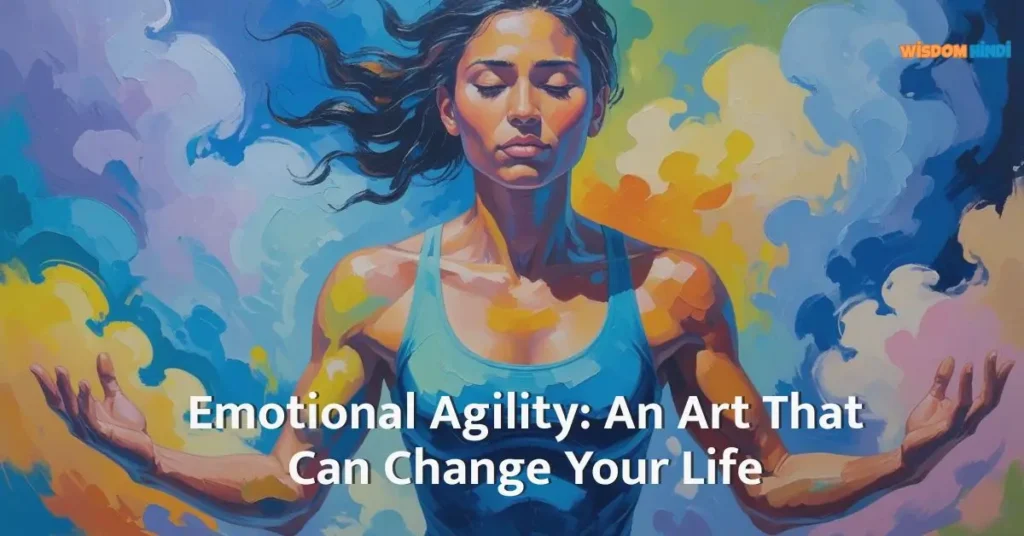
Emotional Agility is a significant term first presented to the world by the famous psychologist Dr. Susan David through her book “Emotional Agility.”
According to her, it is the ability by which a person recognizes his emotions, names them, accepts them, and then responds thoughtfully, and does not react under the influence of emotions.
Understand Emotional Agility in simple words
Emotional Agility means emotional flexibility. It is clear by its name that it talks about bringing flexibility to human emotions. In simple words, in today’s era, a person has to struggle and fight not only with the outside world but also with his inner world. A person somehow comes out of the external challenges. But it is not easy to overcome the things going on inside him.
A person has to deal with so many emotions like anger, sadness, pain, suffering, fear, insecurity, and lack of confidence. These emotions arise inside us every day, and it is not possible to avoid them. These emotions will come but accepting these emotions, then molding them according to your needs without reacting. This ability is called Emotional Agility.
Difference between emotional ego and emotional agility
Many times we refuse to accept the feelings arising inside us. For example, some people are never ready to accept that they can cry or that they are feeling sad. Some will say that they never get angry, while others will say that they are not afraid. All these examples are examples of emotional ego in which people do not accept their feelings, which is very wrong. You should accept your feelings. In emotional agility, it is taught that you accept your feelings, then think about them, and then make your decision, do not let any emotion dominate you.
Read More: What Is Existential Anxiety? Here is A Guide to Understanding and Healing
Ways to increase emotional agility
Express your feelings openly– Expressing your feelings is the first step towards emotional agility. Whatever you are feeling, definitely express it in words. Like I am angry, I am not feeling good. Or I am very happy today. You must express all these feelings.
Do not let your feelings dominate- When you accept the feeling arising inside you, do not let it dominate you. Do not take any decision under the influence of any emotion. Separate your emotions from yourself and whenever such a situation arises where you have to make a decision, then keep the emotions aside and take a decision only based on logical thinking.
Focus on the solution, not the problem- To increase emotional agility, keep in mind that you should never focus on “Why” as much as you should on “What”. It means it is more important to know how to solve a problem than why it is happening. We need to focus on the solution, not on the problem.
Keep up with mindfulness, meditation, and yoga- To increase emotional agility, keep yourself engaged in activities like mindfulness, meditation, and yoga. These activities give you a pause and help a lot in controlling your emotions. Make them a part of your life.
Identify the emotion- If any emotion is arising inside you, then recognize it and accept that yes, I am having such a feeling at this time. After some time this feeling will pass, so I do not have to be affected. The real test of emotional agility is only when we self-control ourselves.
Do not decide with a group, make the decision yourself- It is often seen that people make decisions in the heat of emotions. While making the decision, they involve so many people that it becomes a social decision rather than a personal decision. Therefore, before taking any decision, do not make it a group function, rather talk to your very close people and then make the decision yourself, that too without any emotion.
Conclusion
By adopting various measures to increase Emotional Agility, we see positive changes in our lives. Although this change happens very slowly, its benefits are far-reaching. This is a practice which is formed by small decisions taken every day.
So understand your emotions, accept them, and do not let them dominate you. Because only the one who has flexibility is stable in life. Emotions will keep coming and going. If you control your emotions, then it will benefit you the most and this is also the goal of Emotional Agility.
FAQ- How To Increase Emotional Agility
What do we understand by Emotional Agility?
Emotional agility is the practice of accepting our inner feelings and acting accordingly.
2 thoughts on “Emotional Agility: An Art That Can Change Your Life”